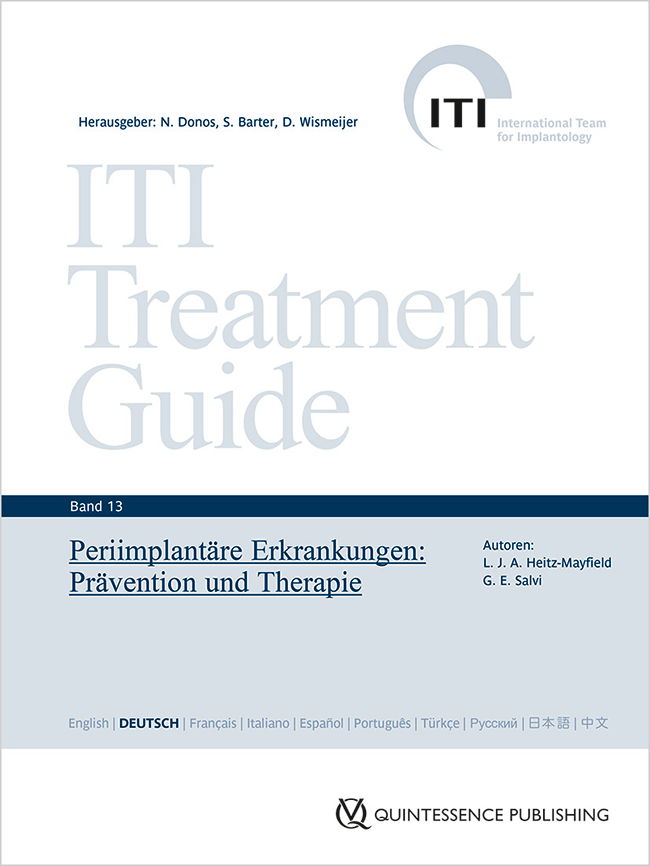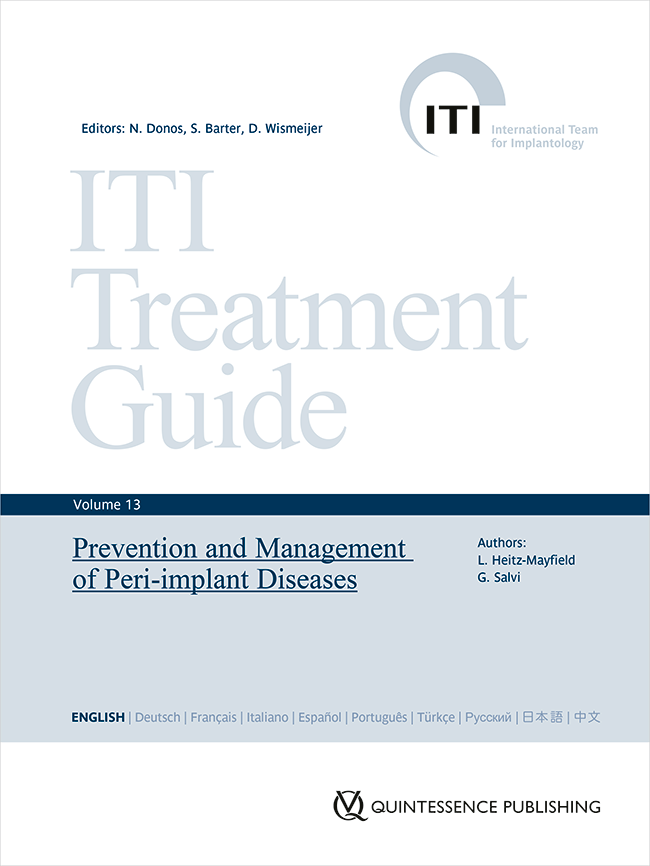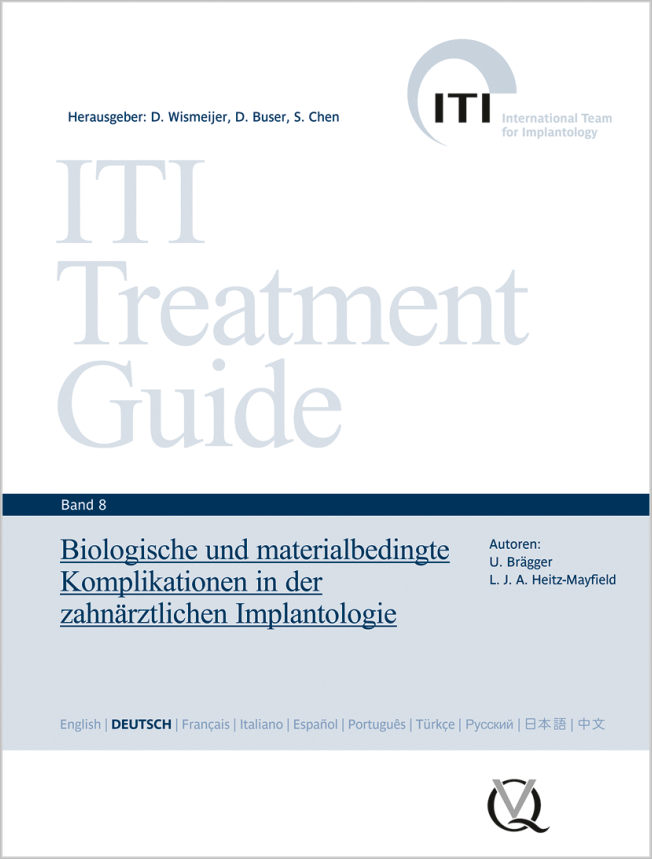2019-1
Pages 64-69, Language: EnglishStadlinger, Bernd / Jepsen, Søren / Terheyden, Hendrik / Heitz-Mayfield, Lisa J. A. / Berglundh, TordThis complementary article was prepared by Bernd Stadlinger, Søren Jepsen and Hendrik Terheyden and presents an overview of the content of the 6th volume of the "Cell-to-Cell Communication" series. The 6th volume of the series entitled "Peri-implantitis and its prevention" was prepared by a collaborative team of authors - Tord Berglundh, Søren Jepsen, Bernd Stadlinger, Hendrik Terheyden - and an advisory board. This computer-animated scientific film was launched at the EuroPerio meeting in Amsterdam in June 2018, providing a novel way to visualize the complex processes of peri-implant inflammation. It visualizes the biological background of the development and progression of peri-implantitis and highlights the importance of the microbiome and host immune defense. In addition, a perspective article has recently been published in the leading implant journal Clinical Oral Implants Research (Berglundh et. al. 2019). It is hoped that this complementary article will bring the film to the attention of the many ITI Fellows and Members who enjoy reading Forum Implantologicum. Please look for the Q reader at the end of the article and enjoy this captivating film.
The International Journal of Oral & Maxillofacial Implants, 7/2014
SupplementDOI: 10.11607/jomi.2014suppl.g5.3, PubMed ID (PMID): 24660207Pages 325-345, Language: EnglishHeitz-Mayfield, Lisa J. A. / Mombelli, AndreaPurpose: To evaluate the success of treatments aimed at the resolution of peri-implantitis in patients with osseointegrated implants.
Materials and Methods: The potentially relevant literature was assessed independently by two reviewers to identify case series and comparative studies describing the treatment of peri-implantitis with a follow-up of at least 3 months. Medline, Embase, and The Cochrane Library were searched. For the purposes of this review, a composite criterion for successful treatment outcome was used which comprised implant survival with mean probing depth 5 mm and no further bone loss.
Results: A total of 43 publications were included: 4 papers describing 3 nonsurgical case series, 13 papers describing 10 comparative studies of nonsurgical interventions, 15 papers describing 14 surgical case series, and 11 papers describing 6 comparative studies of surgical interventions. No trials comparing nonsurgical with surgical interventions were found. The length of follow-up varied from 3 months to 7.5 years. Due to the heterogeneity of study designs, peri-implantitis case definitions, outcome variables, and reporting, no metaanalysis was performed. Eleven studies could be evaluated according to a composite success criterion. Successful treatment outcomes at 12 months were reported in 0% to 100% of patients treated in 9 studies and in 75% to 93% of implants treated in 2 studies. Commonalities in treatment approaches between studies included (1) a pretreatment phase, (2) cause-related therapy, and (3) a maintenance care phase.
Conclusions: While the available evidence does not allow any specific recommendations for the therapy of peri-implantitis, successful treatment outcomes at 12 months were reported in a majority of patients in 7 studies. Although favorable short-term outcomes were reported in many studies, lack of disease resolution as well as progression or recurrence of disease and implant loss despite treatment were also reported. The reported outcomes must be viewed in the context of the varied peri-implantitis case definitions and severity of disease included as well as the heterogeneity in study design, length of follow-up, and exclusion/inclusion criteria.
Keywords: peri-implantitis, systematic review, treatment, therapy
The International Journal of Oral & Maxillofacial Implants, 7/2014
SupplementDOI: 10.11607/jomi.2013.g5, PubMed ID (PMID): 24660208Pages 346-350, Language: EnglishHeitz-Mayfield, Lisa J. A. / Needleman, Ian / Salvi, Giovanni E. / Pjetursson, Bjarni E.The International Journal of Oral & Maxillofacial Implants, 7/2009
SupplementPubMed ID (PMID): 19885434Pages 39-68, Language: EnglishHeitz-Mayfield, Lisa J. A. / Huynh-Ba, GuyPurpose: The aim of this review was to evaluate a history of treated periodontitis and smoking, both alone and combined, as risk factors for adverse dental implant outcomes.
Materials and Methods: A literature search of MEDLINE (Ovid) and EMBASE from January 1, 1966, to June 30, 2008, was performed, and the outcome variables implant survival, implant success, occurrence of peri-implantitis and marginal bone loss were evaluated.
Results: Considerable heterogeneity in study design was found, and few studies accounted for confounding variables. For patients with a history of treated periodontitis, the majority of studies reported implant survival rates > 90%. Three cohort studies showed a higher risk of peri-implantitis in patients with a history of treated periodontitis compared with those without a history of periodontitis (reported odds ratios from 3.1 to 4.7). In three of four systematic reviews, smoking was found to be a significant risk for adverse implant outcome. While the majority of studies reported implant survival rates ranging from 80% to 96% in smokers, most studies found statistically significantly lower survival rates than for nonsmokers.
Conclusions: There is an increased risk of peri-implantitis in smokers compared with nonsmokers (reported odds ratios from 3.6 to 4.6). The combination of a history of treated periodontitis and smoking increases the risk of implant failure and peri-implant bone loss.
Keywords: implant success, implant survival, peri-implantitis, periodontitis, smoking, tobacco
The International Journal of Oral & Maxillofacial Implants, 7/2009
SupplementPubMed ID (PMID): 19885436Pages 86-89, Language: EnglishCochran, David L. / Schou, Søren / Heitz-Mayfield, Lisa J. A. / Bornstein, Michael M. / Salvi, Giovanni E. / Martin, William C.Implantologie, 2/2005
SupplementPages 127-138, Language: GermanHeitz-Mayfield, Lisa J. A. / Lang, Niklaus P.Zielsetzung: Dieser Übersichtsartikel dokumentiert die vorliegende Literatur zu Behandlungsformen bei periimplantären Erkrankungen unter besonderer Berücksichtigung von lokalen und systemischen antimikrobiellen Therapien mit Antiseptika und Antibiotika.
Material und Methode: In der Datenbank MEDLINE, dem Cochrane Controlled Trials Register und Cochrane Health Group Specialized Register wurden englischsprachige Arbeiten zu diesem Thema recherchiert (Stichtag 31. Juli 2003). Der vorliegende Artikel beleuchtet die in Tierversuchen und klinischen Studien gewonnenen Erkenntnisse.
Resultate: In der Literatur werden zahlreiche antimikrobielle Behandlungsansätze beschrieben. Dabei wurden nichtchirurgische und chirurgische Säuberungsmethoden mit oder ohne regenerative Therapien angewendet. Die Art, Dosierung und Zufuhr der antimikrobiellen Substanzen variierte ebenso wie die Zeitpunkte, zu denen Antibiotikabehandlungen eingeleitet wurden. Ob diese Substanzen von den Patienten korrekt angewendet wurden und welche unerwünschten Wirkungen sie hatten, wurde in den wenigsten Fällen thematisiert.
Diskussion: Die meisten der ausgewerteten Fallberichte und Studien zeigten zwar positive Resultate, umfassten jedoch keine unbehandelten Kontrollgruppen. Aussagen über die relative Wirksamkeit der verwendeten Substanzen können daher nicht getroffen werden.
Schlussfolgerung: Antimikrobielle Substanzen werden bei periimplantären Erkrankungen auf breiter Basis eingesetzt, ihr objektiver Nutzen ist aber nur schlecht dokumentiert. Diese Lücke sollte, soweit ethisch vertretbar, durch randomisierte kontrollierte Studien geschlossen werden. Auch prospektive Kohortenstudien zu verschiedenen Behandlungsabläufen bei konsekutiven Patienten wären erforderlich.
Keywords: Antimikrobielle Substanzen, Behandlung, Dentalimplantate, periimplantäre Erkrankungen, periimplantäre Infektionen, periimplantäre Mukositis, Periimplantitis
The International Journal of Oral & Maxillofacial Implants, 7/2004
SupplementPages 128-139, Language: EnglishHeitz-Mayfield, Lisa J. A. / Lang, Niklaus P.Purpose: To review the literature on the treatment of peri-implant diseases. Specific emphasis was placed on the use of antimicrobial therapy, defined as local or systemic administration of antiseptic and/or antibiotic agents.
Materials and Methods: A search of MEDLINE, the Cochrane Controlled Trials Register, and The Cochrane Health Group Specialized Register was conducted, and articles published in English until July 31, 2003, were included. The results of experimental animal studies and human research are presented.
Results: A variety of antimicrobial treatment regimens in combination with nonsurgical or surgical debridement with and without regenerative therapy were reported. Use of antimicrobials varied between studies with respect to type of drug, dosage, delivery system, duration, and commencement of antibiotic administration. Patient compliance and adverse effects related to the antimicrobials were mostly not mentioned.
Discussion: While the majority of the case reports and studies presented showed positive outcomes following antimicrobial treatment, there were no nonmedicated controls included, so the relative effect of the antimicrobial agent(s) cannot be evaluated.
Conclusions: Although antimicrobials are widely used for the treatment of peri-implant diseases, evidence of their benefit is limited, and randomized, controlled human trials should be initiated where ethically possible. In addition, prospective cohort studies designed to monitor consecutive cases treated using specific treatment protocols are required.






